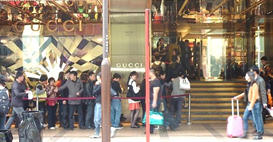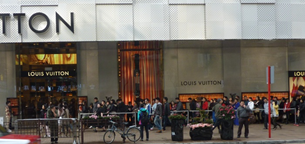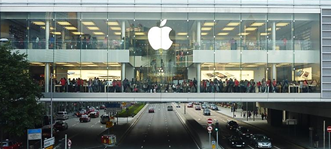It did not escape the notice of my partner as we walked down Nathan Road in Hong Kong that the local couple ahead of us were carrying a plethora of bags from Gucci, Chanel and a host other top designers, while our bag bore the Chinese logo of one of the local emporiums. Having sought out in vain the great local goods and technology deals we used to find here just a few years ago, we had reluctantly came to the conclusion that we were standing in the next great bastion of high end consumerism. Gone are many local shops and outlets, replaced by designer names on every corner and giant shopping malls that offer soft music, stores-in-stores and richly designed aesthetics. Just like you would find in New York, Paris, London or Tokyo – only more expensive in many cases! With 10 Gucci stores/stores-in-stores in Hong Kong (home to 7 million people), the density of stores per capita is already higher than in London or Tokyo.

Even more interesting, given it was New Year sales season, was the sheer number of people crowding these designer stores. Queues were waiting their turn patiently to tread the hallowed carpets of Prada, Louis Vuitton, Gucci, Balmain, Chanel and more in search of that exclusive bargain, spending thousands of dollars (Hong Kong or US, as you wish) to be able to wear or display the real thing. And the real thing is the key.

There seems to have been a role reversal in consumer thinking between the developed and rapidly developing world. As consumers in the West struggle with austerity, the daily deals and cheap is chic mindsets are gaining ground. Why spend all that money for a high end label when the big chains are rolling out lines under designer names at a fraction of the price? Or you can get a great deal on it?
Not so in Hong Kong – or Vietnam for that matter, where the designer stores are also making strong inroads even though import taxes mean goods cost 30% more than in Western markets. The few with plenty of cash to spare in Vietnam’s equivalent of Los Angeles, Saigon, have no qualms about prices. Labels matter. High end labels matter even more and it is worth the saving and the wait to secure that landmark piece or accessory. Although the Luxury Institute’s trends for 2012 suggests that luxury executives are wondering whether the fundamentals for rapid growth both locally and globally, including China, are waning a bit, they will certainly find some New Year cheer here.
The shift in consumer spending power towards rapidly developing economies is more marked than ever before, and as incomes rise, these markets are likely to become key drivers of future trends, not only for luxury goods but other key categories, such as consumer electronics. Research out ahead of the annual Consumer Electronics Show in Las Vegas suggests that sales of consumer electronics worldwide will exceed US$ 1 trillion this year, much of the growth driven by rapidly developing economies including China and India – the Hong Kong Apple store offers a glimpse of the crowds there (even without a sale on). Developing countries will account for 46% of global gadget sales in 2012, up from 37% four years ago, according to UK-based GfK Boutique Research and the Consumer Electronics Association. The evidence is clear in the streets and homes of Hong Kong and Hanoi where, for example, flat screen TVs can be seen in the smallest of apartments and smartphones are the must-have device.

As this role reversal in consumer spending and attitudes continues, look out for more and more innovative retail and consumer goods trends coming out of the rapidly developing world. What used to be the bottom/middle of the market pyramid is now driving the top. And the place to go for cheap/discount goods is now the US, changing national stereotypes even further. Looking ahead, this role reversal could also play out in many other industries. What are the implications for your organization?



